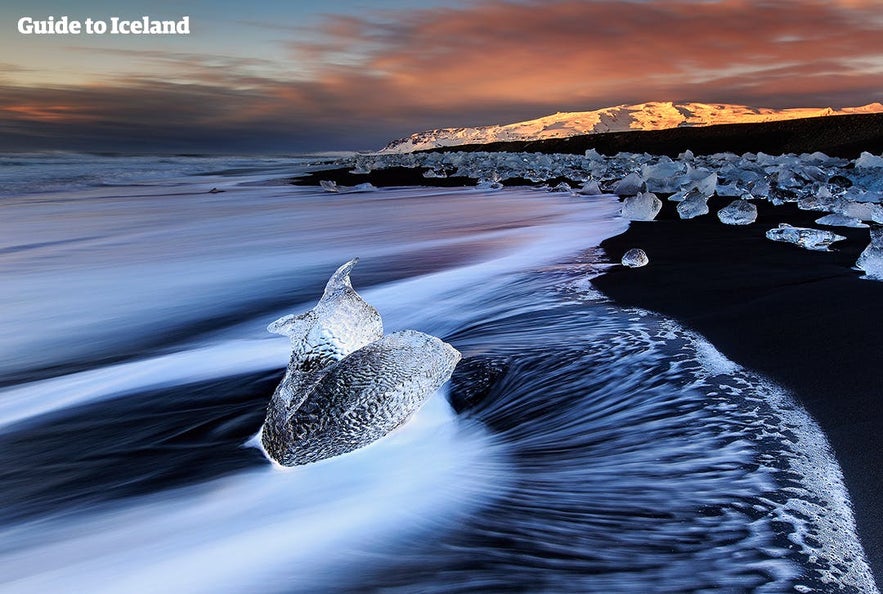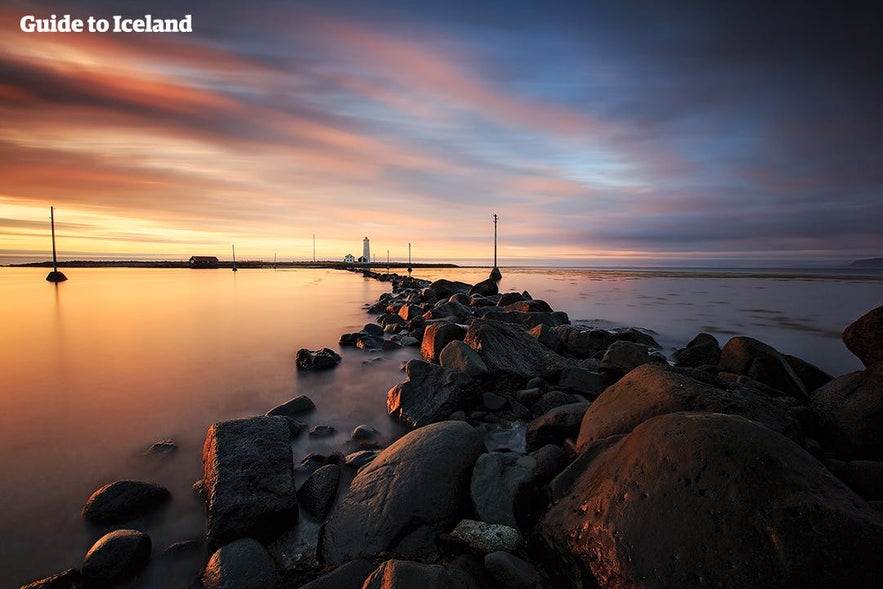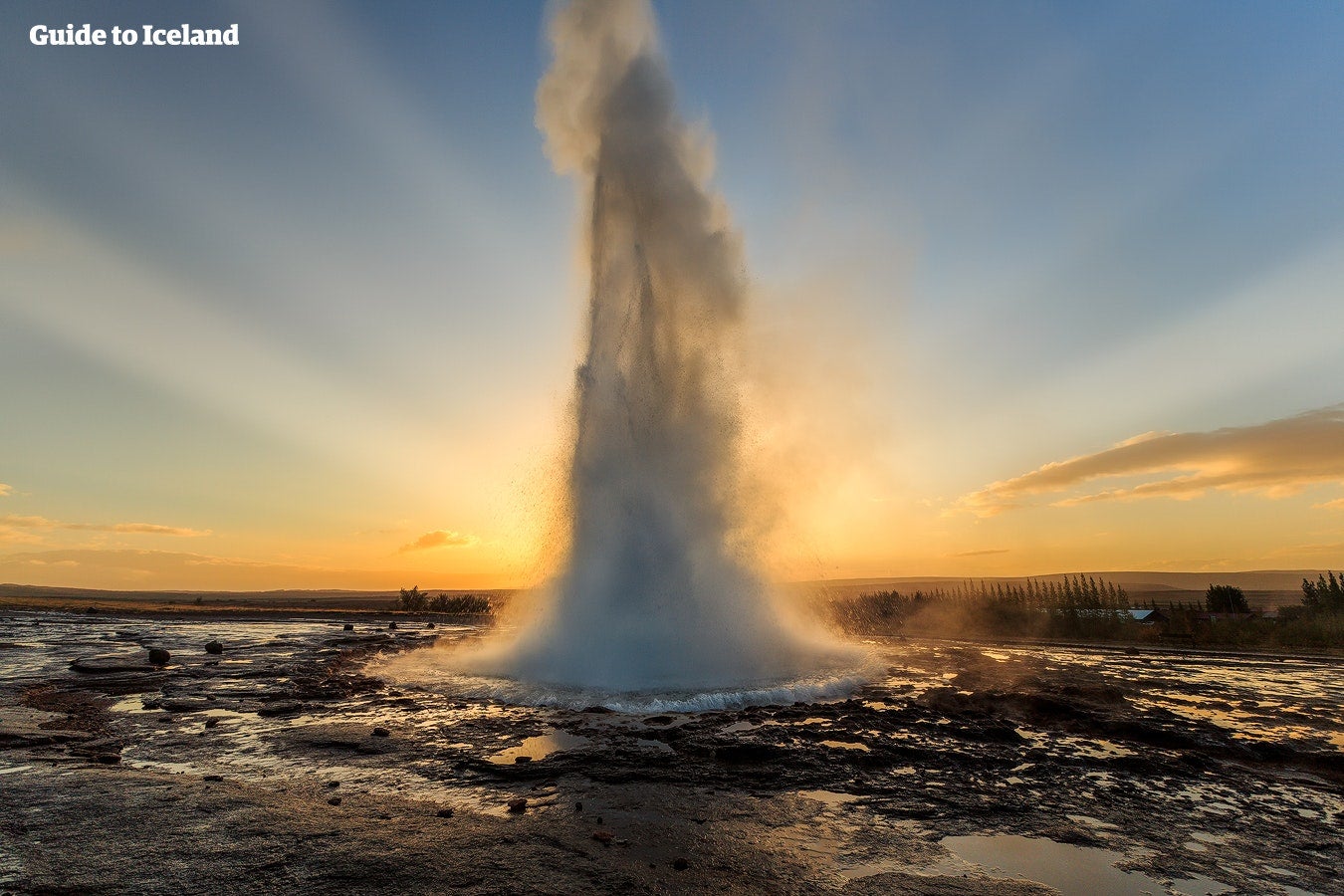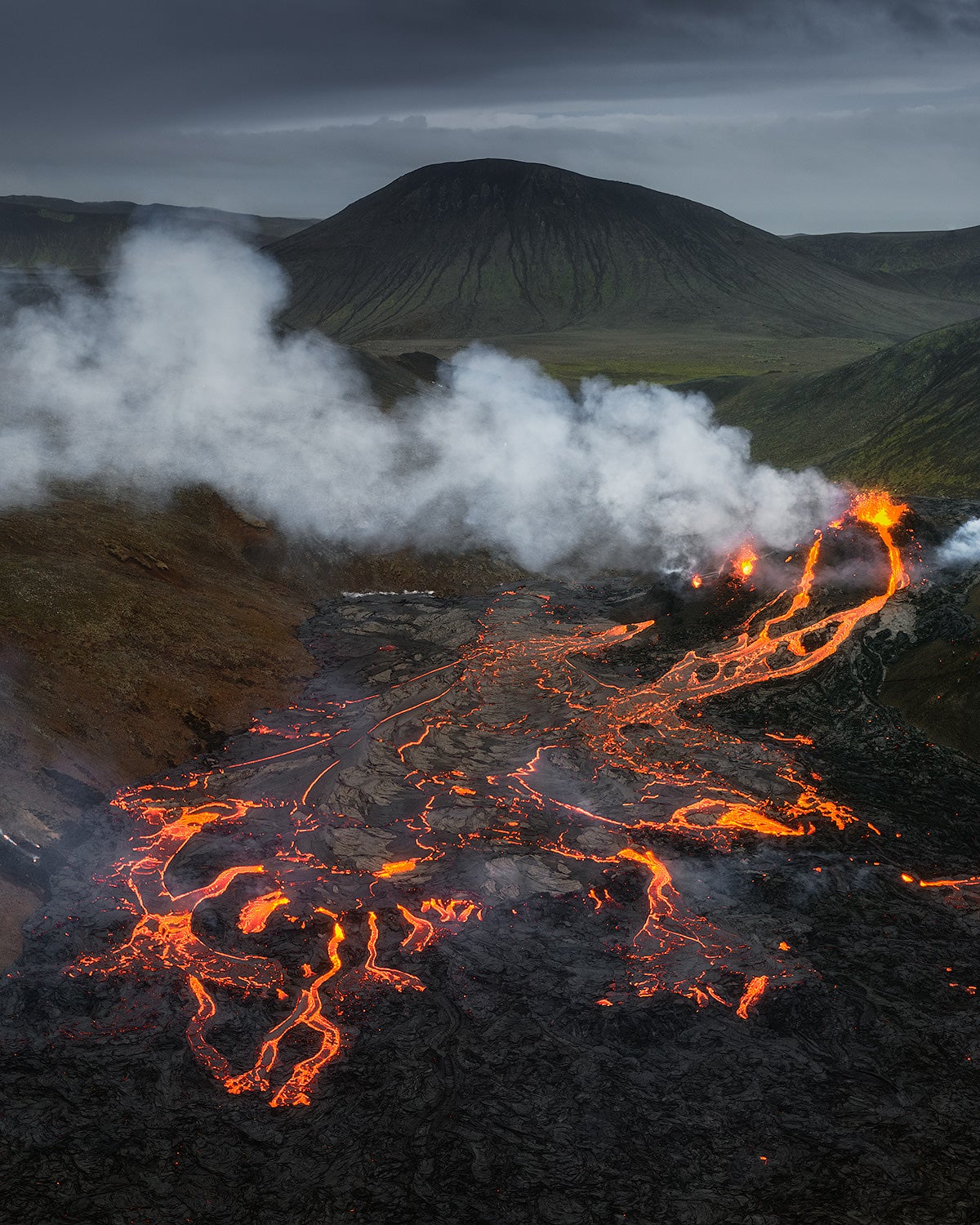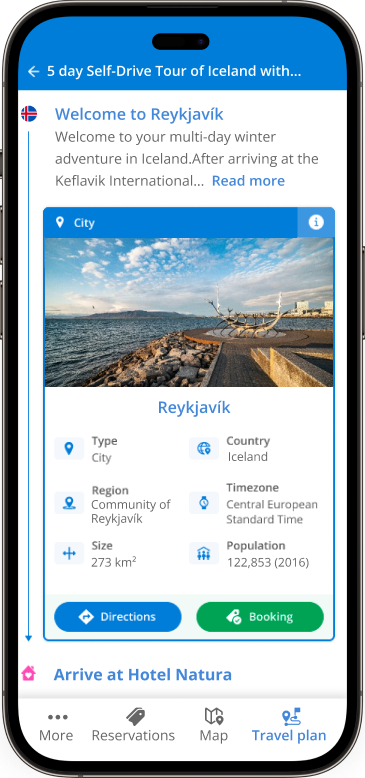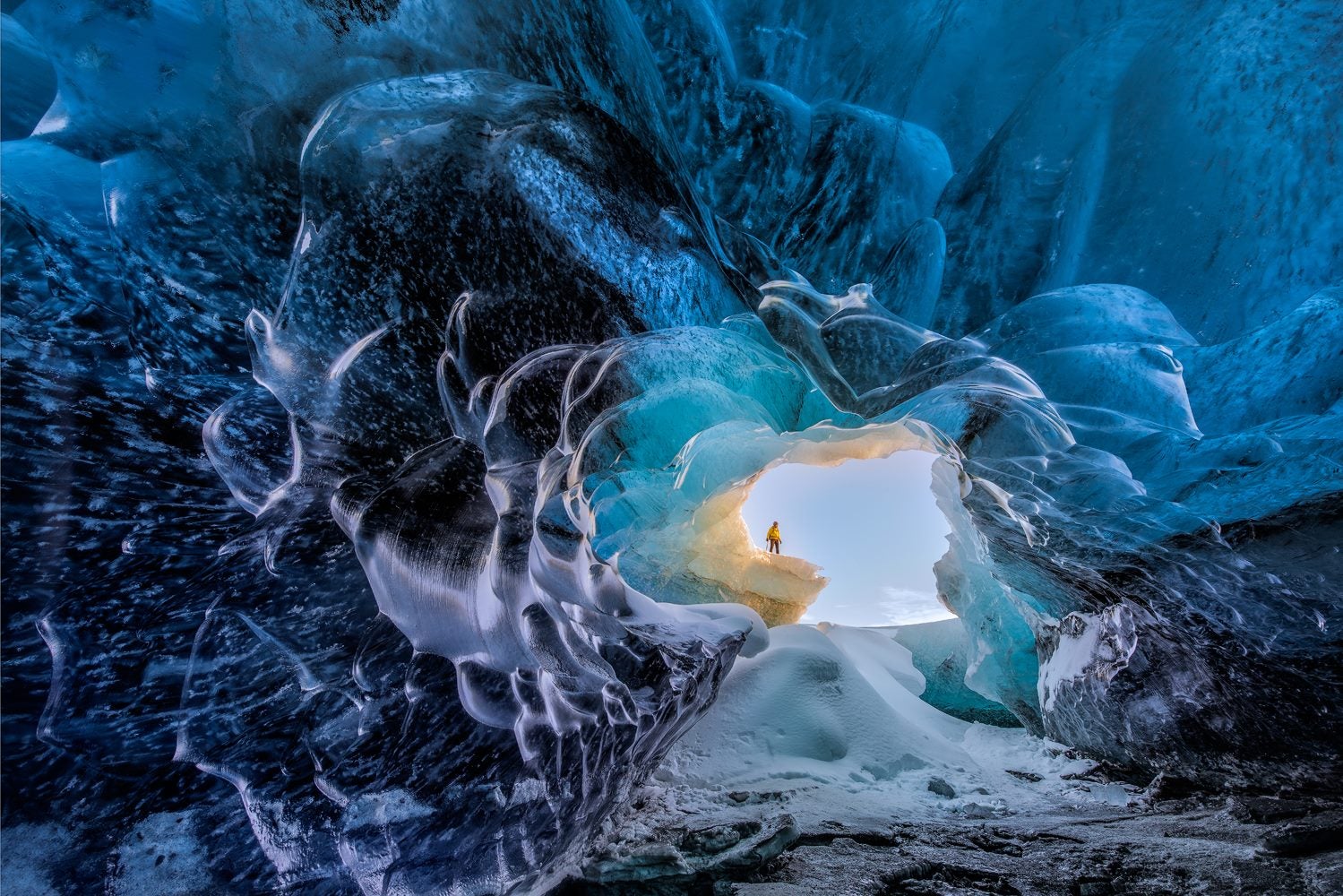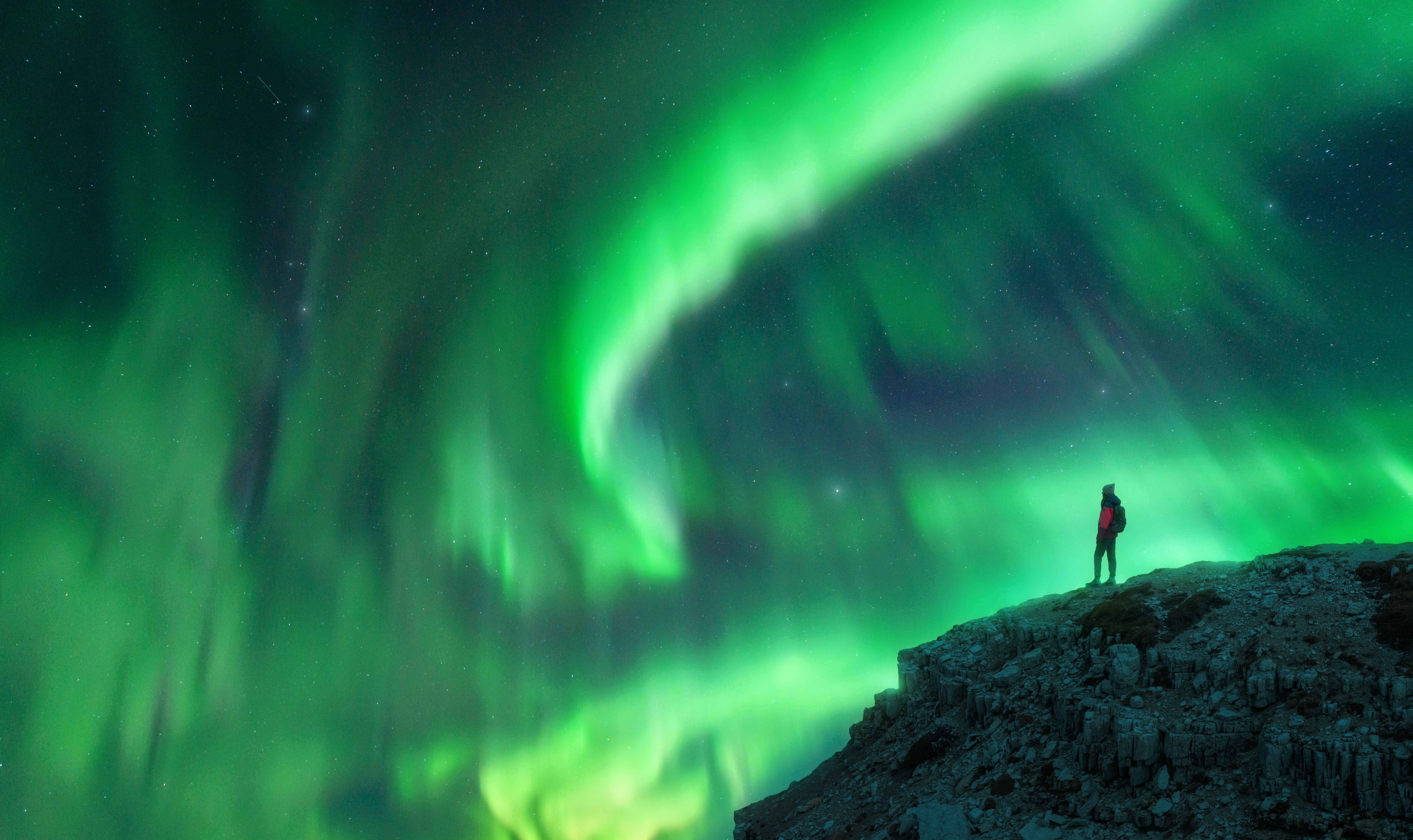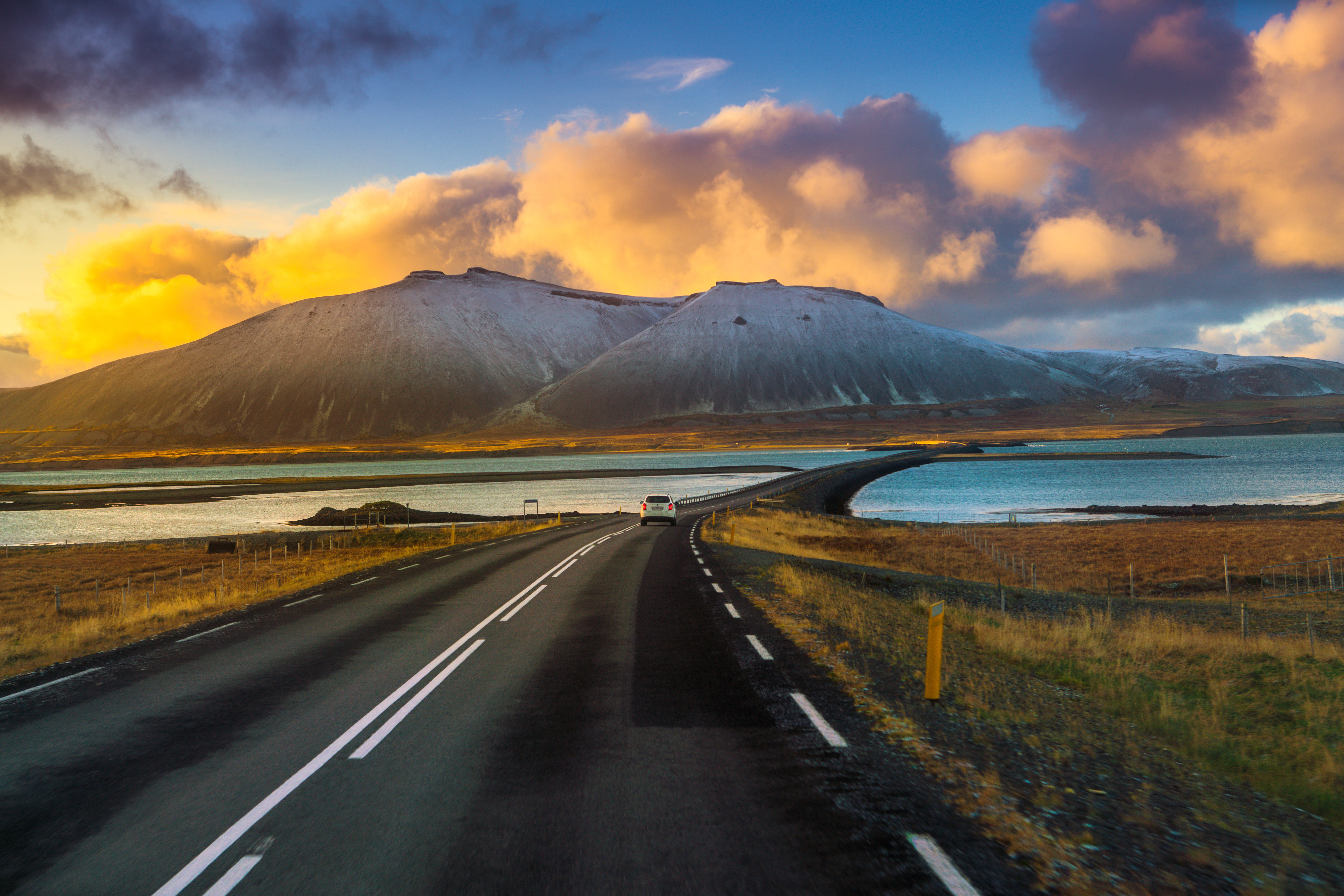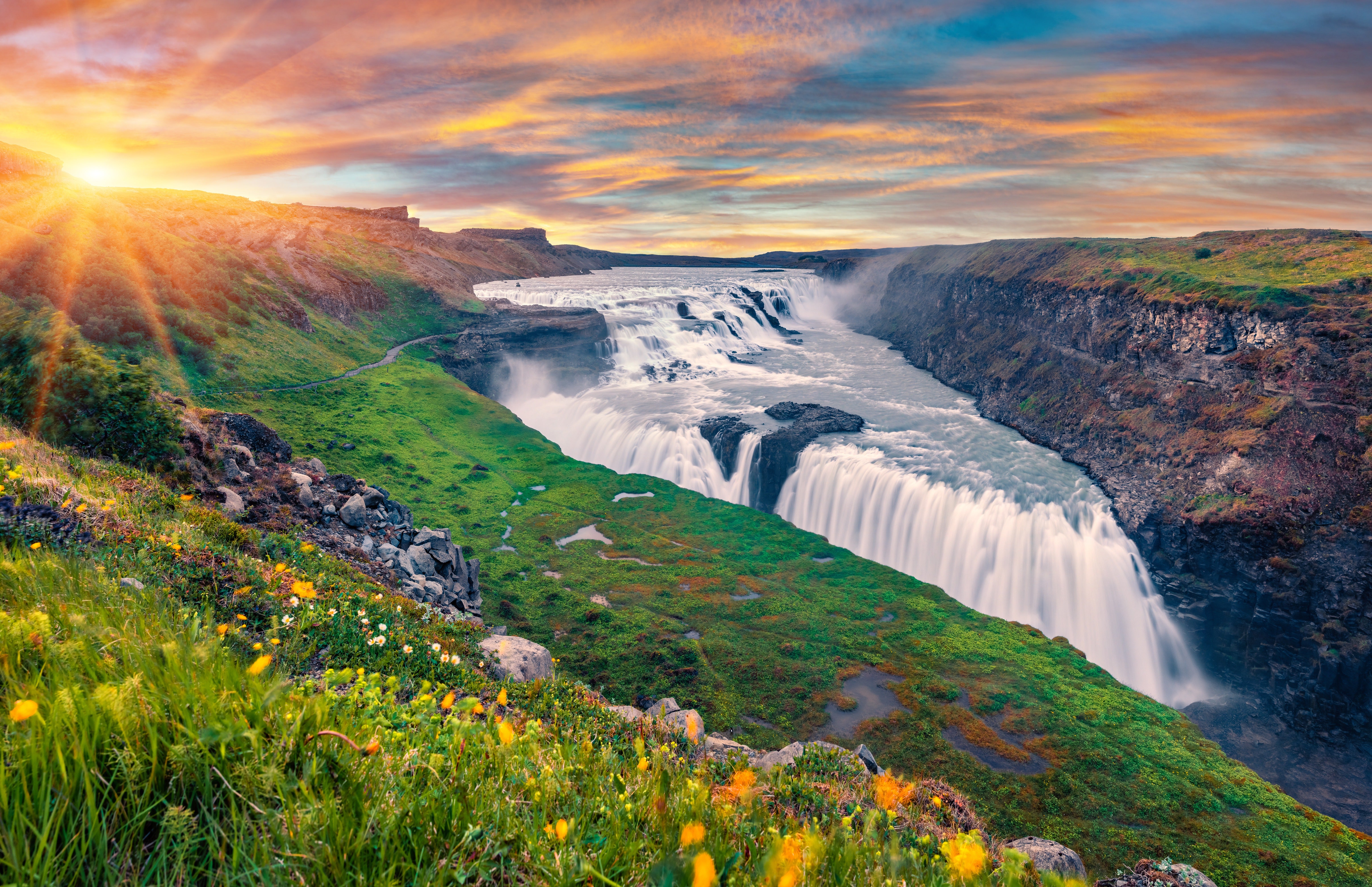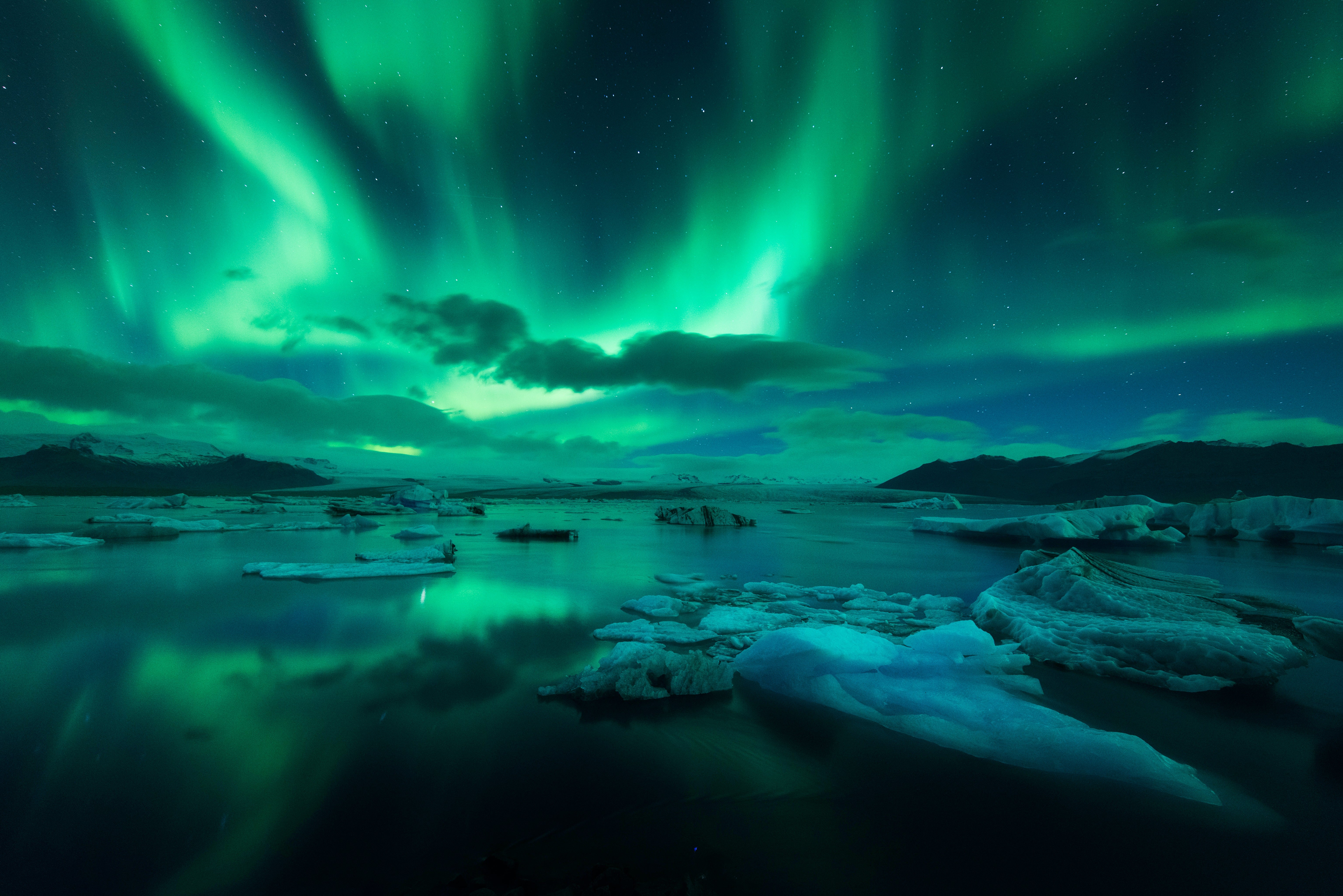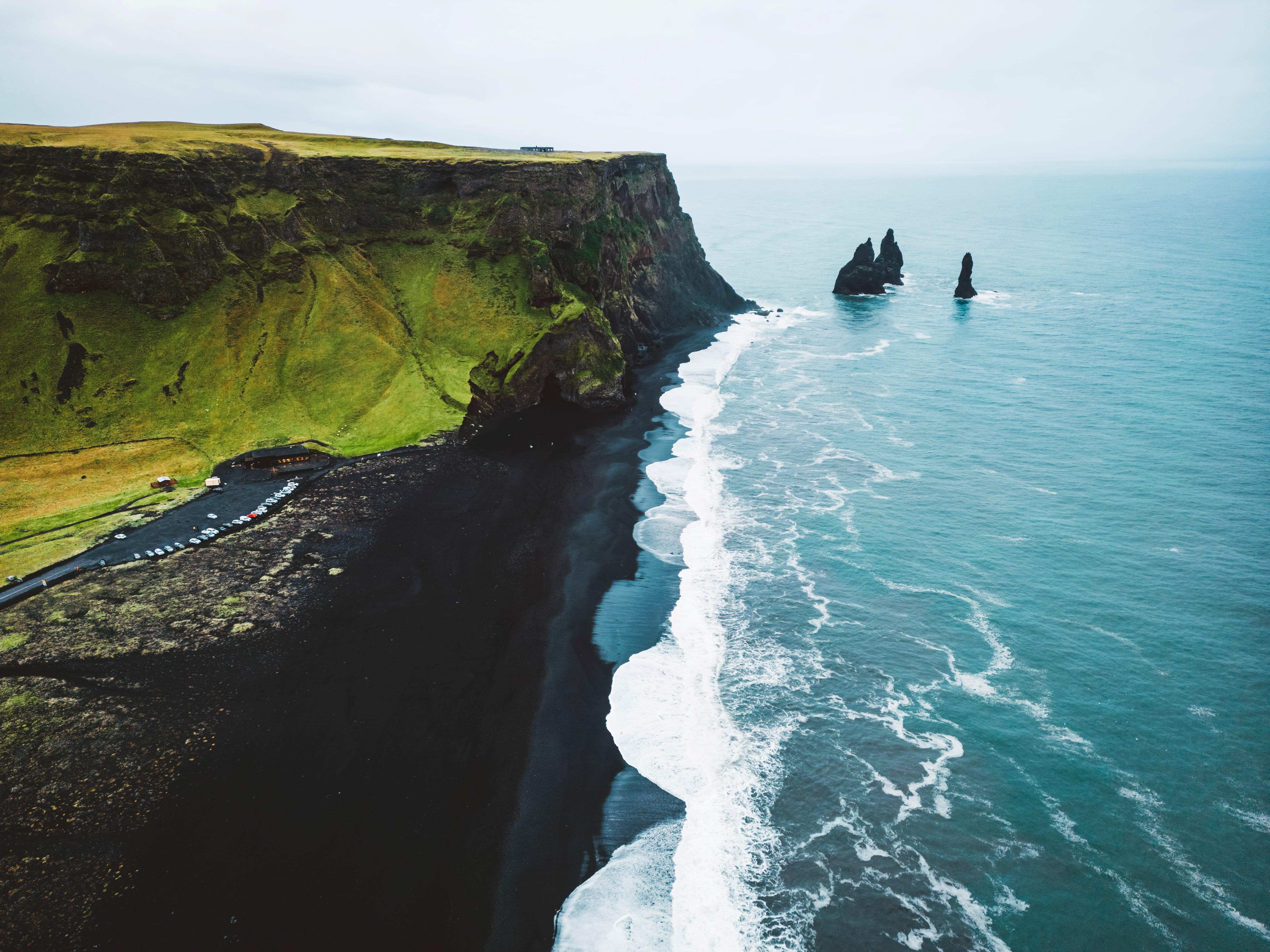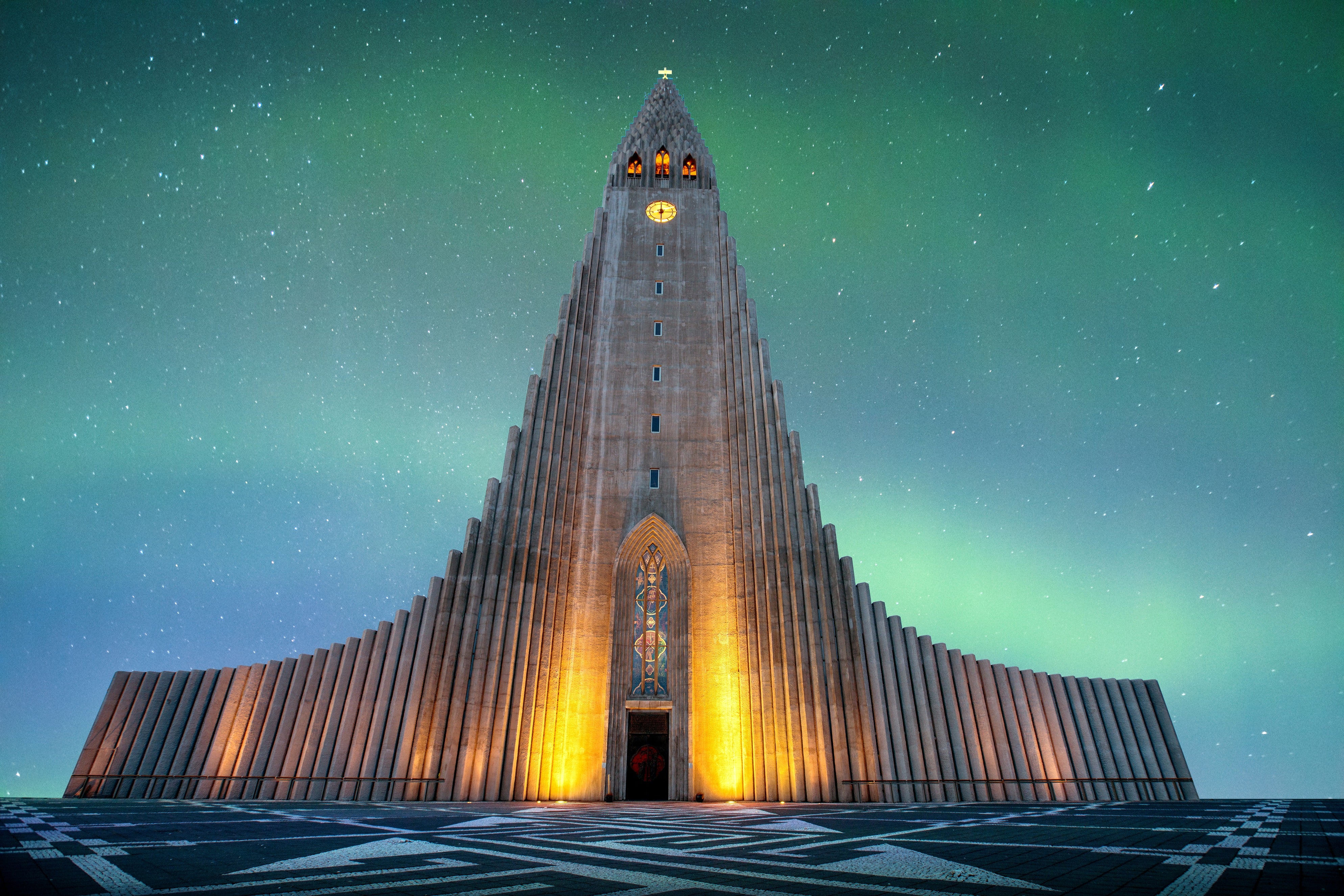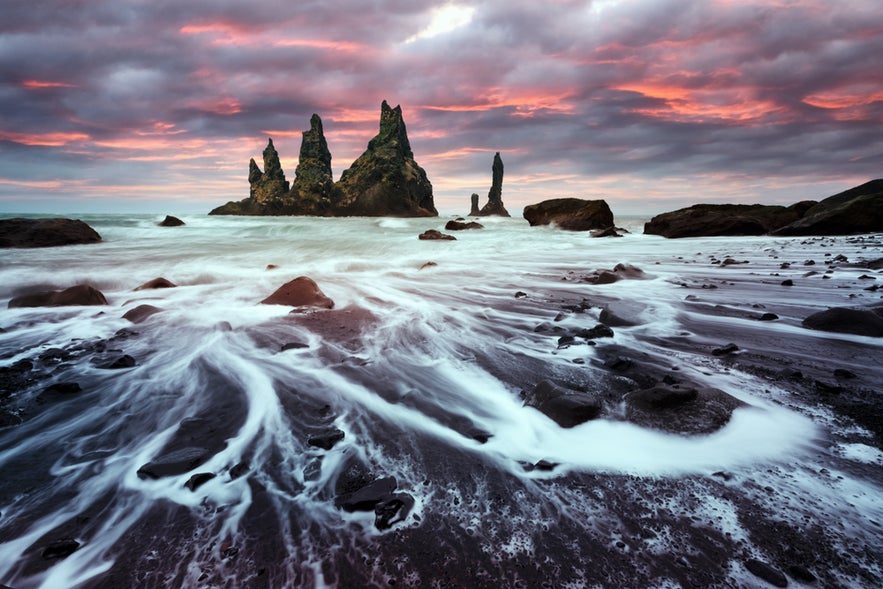
The black sand beaches in Iceland are full of unique landscapes and interesting geographic formations. Discover which beaches are the most admired by visitors and Icelanders.
When you imagine a trip to the beach, you probably picture a sunny resort with tropical trees and white sand. In Iceland, the beaches you'll see on road trips around Iceland or on South Coast tours are much different.
Why You Can Trust Our Content
Guide to Iceland is the most trusted travel platform in Iceland, helping millions of visitors each year. All our content is written and reviewed by local experts who are deeply familiar with Iceland. You can count on us for accurate, up-to-date, and trustworthy travel advice.
They’re a testament to how the country has been shaped by volcanic forces, with volcanic cliffs welcoming the crashing waves against the shore.
Whether you rent a car to experience Iceland on your own or book self-drive tours, you’ll find many astonishing black sand beaches. Waking up at a hotel or guesthouse in Iceland with a view of the harsh yet beautiful coastline is sure to inspire you to explore everything the country has to offer.
Read on to learn about the best beaches in Iceland.
- See also: 40 Best Locations in Iceland
- See also: 18 Things To Do and Places To Visit in Iceland
Key Takeaways
-
Iceland is known for its haunting and beautiful black sand beaches that were formed over centuries by volcanic activity.
-
Sneaker waves are common on Icelandic beaches and can pose a threat to beachgoers if not taken seriously.
-
Get to know Iceland’s most popular black sand beaches so you can decide which ones to see during your trip.
-
There are plenty of other traditional beaches that offer scenic views and activities.
What Makes the Sand on Iceland Beaches Black?
As an island at the edge of the Arctic, Iceland is home to a myriad of enchanting black sand beaches. They’re formed from volcanic rock called basalt. When hot lava flows into the cool ocean, it solidifies quickly and shatters into tiny fragments, creating black sand.
Over time, natural erosion breaks down the basalt rocks into finer particles that accumulate along the shoreline, creating the iconic beaches. This phenomenon is also found in other parts of the world, such as in Punalu’u Black Sand Beach in Hawaii.
Iceland's volcanoes sculpt the landscape. This means a significant amount of sand on its beaches is basalt, creating scenery that can feel odd, majestic, and otherworldly.
Not all Icelandic beaches are black. White, yellow, and gold sand is common on the Snaefellsnes Peninsula and in the Westfjords. A few more are located in and around Reykjavik.
Discover Your Favorite Iceland Beach
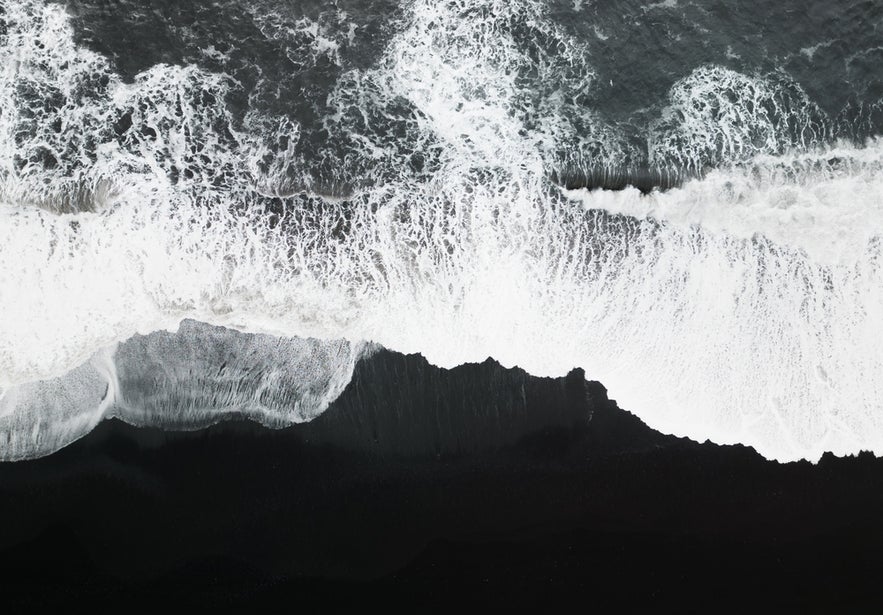 Without further ado, let's take a stroll along the top black sand beaches in Iceland. Be sure to read until the end to learn about some of the country's white sand beaches. There’s also a handy map to help you find these amazing locations.
Without further ado, let's take a stroll along the top black sand beaches in Iceland. Be sure to read until the end to learn about some of the country's white sand beaches. There’s also a handy map to help you find these amazing locations.
8. Djupalonssandur Beach
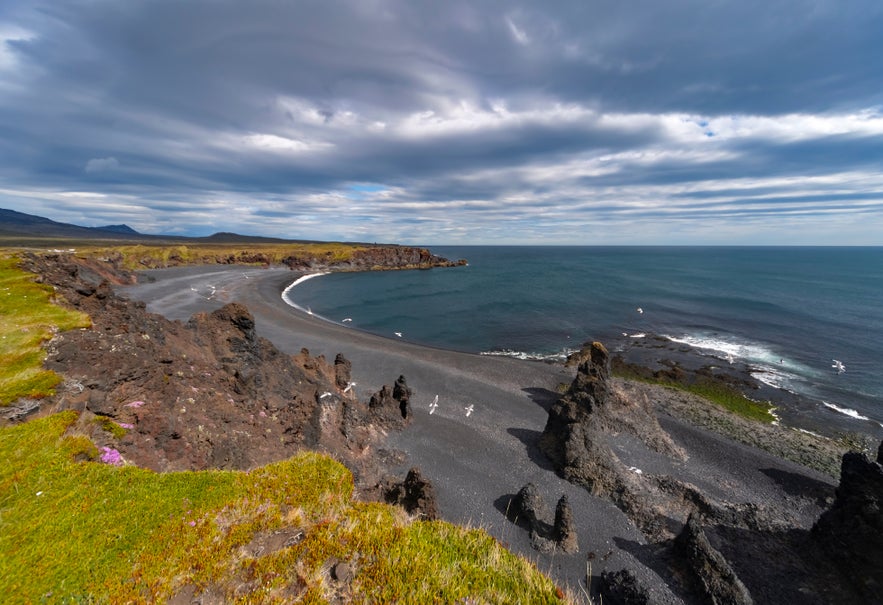
Located on the Snaefellsnes Peninsula, Djupalonssandur Beach is a wonderful attraction that was once home to a bustling fishing village. The coastline has a rich blend of history and natural beauty, with certain details providing insight into past residents and practices.
Four ancient lifting stones still occupy the beach, once used to test the strength of the local fishermen. Djupalonssandur Beach is also home to remnants of an English trawler shipwrecked in the mid-20th century. The wreckage is a powerful reminder of the harsh but beautiful force of the ocean.
You'll find two freshwater lagoons behind the cliffs of volcanic rock that surround the beach. These lagoons are steeped in rich folklore.
- See also: Folklore in Iceland
- See also: The Ultimate Guide to the Snaefellsnes Peninsula
Booking a small-group tour of the Snaefellsnes Peninsula is a great way to visit the area. A guide will provide detailed insight into the fascinating stories and geology of Djupalonssandur Beach. This is your chance to enjoy the scenery and rich historical heritage to the fullest.
Keep in mind that this beach is not for wading, as powerful sneaker waves can surprise you. Sneaker waves are unpredictably large and powerful coastal waves in Iceland that can suddenly surge onto the beach. More information about sneaker waves is available below.
7. Eyrarbakki Beach
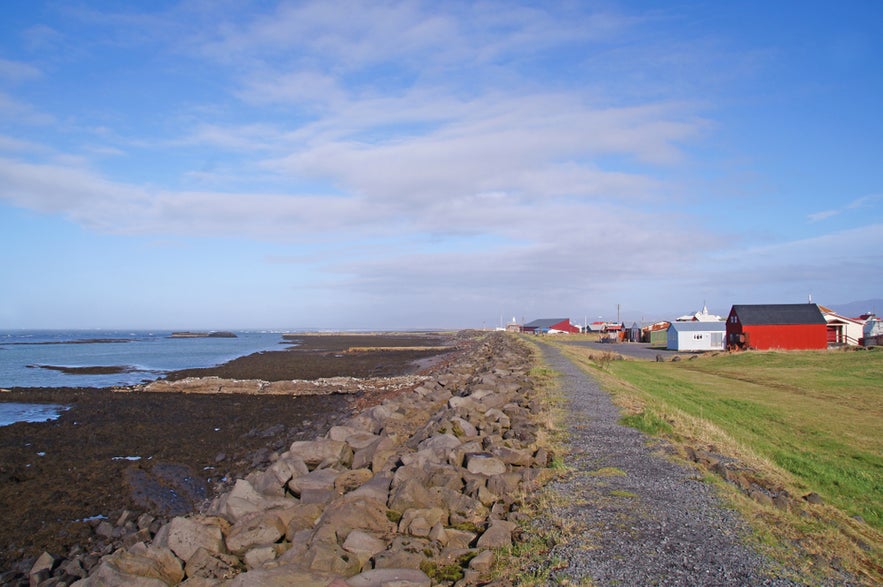 Eyrarbakki is a small village situated along Iceland's South Coast. It’s a quiet and less-traveled destination where you won't find the bustling tourist amenities common to other spots. This lends itself to Eyrarbakki’s untouched charm.
Eyrarbakki is a small village situated along Iceland's South Coast. It’s a quiet and less-traveled destination where you won't find the bustling tourist amenities common to other spots. This lends itself to Eyrarbakki’s untouched charm.
Eyrarbakki Beach is full of stones and rocks rather than fine sand. Here, you’ll find an old harbor and piers, remnants of the village's abandoned fishing heritage. These relics of maritime culture, the ecosystem, and coarse black rocks create a powerful visual. It’s an ideal beach for photography.
As a less-visited location, Eyrarbakki Beach is a hidden gem you can enjoy without the distracting frills of commercial tourist destinations. The village offers an escape into the calm rhythms of coastal life.
6. Grotta Beach
You don’t have to venture outside of Reykjavik to find a stunning black sand beach. Grotta Nature Reserve is in Seltjarnarnes Township, 3 miles (5 kilometers) from the Reykjavik city center. Its black sand beach outlines the rugged coastline.
The area was originally inhabited as early as the 1500s. Today, residents primarily include seabirds. Grotta Beach is off-limits during nesting season, which takes place from May to June. It’s open any other time of the year.
- See also: Secret Spots & Hidden Gems in Reykjavik
The most iconic sight at Grotta Beach is the lighthouse. It stands as a solitary beacon against the backdrop of the vast North Atlantic Ocean and offers a historic contrast to the modern developments around it. When the tide is low, you can walk right up to the lighthouse.
Also found at Grotta Beach is an intriguing wooden structure for drying fish. After a bit of exploring, dip your feet into the Kvika, a small geothermal pool near the lighthouse.
Despite being close to the city center, Gotta Beach’s relative seclusion makes it one of the best spots in Reykjavik to see the northern lights in winter.
5. Sandvik Beach
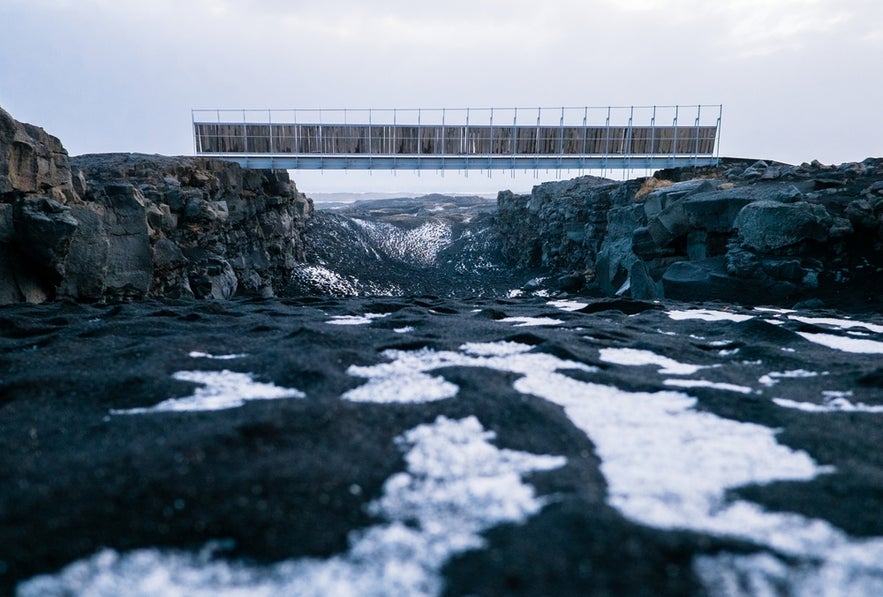 At the southwest tip of the Reykjanes Peninsula lies the black sands of Sandvik Beach. The area is best known for being home to the “Bridge Between Continents,” a structure symbolizing Iceland's location atop the Mid-Atlantic Ridge. It separates the North American and Eurasian tectonic plates.
At the southwest tip of the Reykjanes Peninsula lies the black sands of Sandvik Beach. The area is best known for being home to the “Bridge Between Continents,” a structure symbolizing Iceland's location atop the Mid-Atlantic Ridge. It separates the North American and Eurasian tectonic plates.
Iceland’s unique location on the ridge means that the western part of the country is technically in America, while the eastern side is in Europe. The Bridge Between Continents is a great symbol for this, and visitors enjoy crossing it and stepping between two continents.
- See also: 22 Best Things To Do in the Reykjanes Peninsula
- See also: Best Hotels Near Keflavik Airport
Sandvik Beach is a popular stop when exploring Reykjanes. It was the shooting location of Clint Eastwood's “Flags of Our Fathers.”
The beach is conveniently close to Keflavik International Airport. It’s a great first stop if you’re renting a car from the airport and want to jumpstart your trip with some awe-inspiring scenery.
4. Solheimasandur
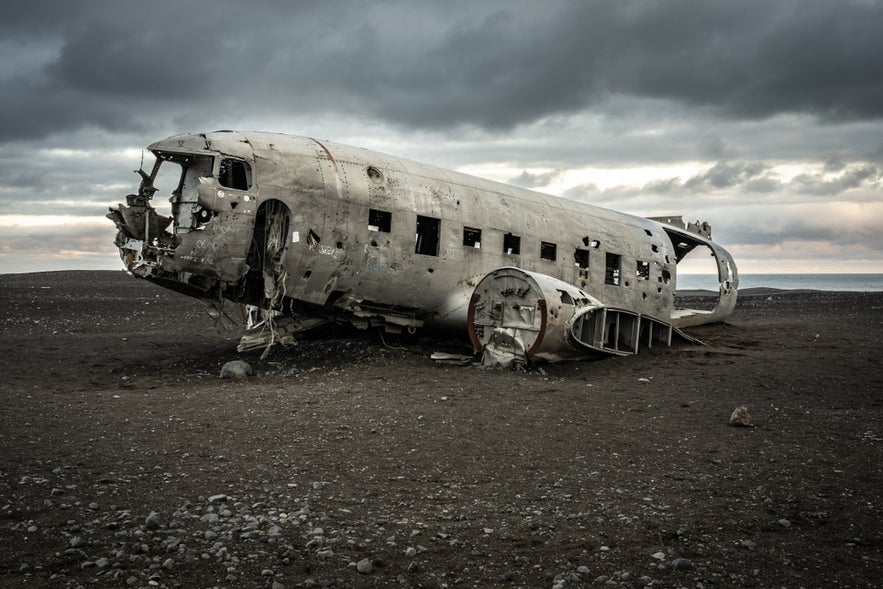
Many landscapes in Iceland are constantly in flux due to the country's volcanic activity. For a striking visual display of the land's volcanic nature, look no further than the glacial sand plains of Solheimasandur on the South Coast.
This desert of black sand was formed a few centuries ago by a massive glacier outburst flood caused by eruptions from the infamous Katla Volcano. Each time this powerful volcano erupts, it has a tremendous effect on the surrounding environment.
Solheimasandur is also home to a US Navy DC3 airplane that crashed in 1973. The crew members survived but abandoned the plane, leaving behind an accidental monument. The aircraft's gnarled metal on the black sand makes for interesting photography.
- See also: The Abandoned DC Plane on Solheimasandur
There’s a parking lot off the road near the wreck, but prepare for quite a hike. Alternatively, you could book a round-trip shuttle bus transfer that takes you directly from the parking lot to the wreck and back. If you’re a thrill-seeker, book an ATV tour of Solheimasandur and zoom over the black sands.
3. Stokksnes Beach
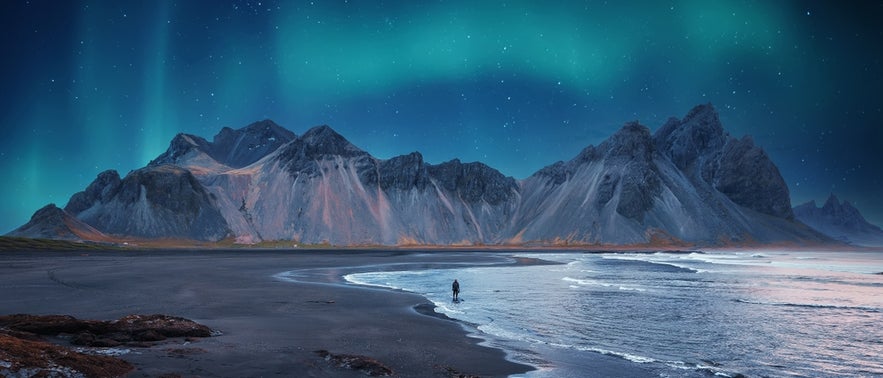 Stokksnes Beach is on the headland of the Stokksnes Peninsula in the Eastfjords. The magnificent black sand stretches out from the foot of the spectacular Vestrahorn Mountain. This is every photographer’s dream, as natural forces continually shape the landscape.
Stokksnes Beach is on the headland of the Stokksnes Peninsula in the Eastfjords. The magnificent black sand stretches out from the foot of the spectacular Vestrahorn Mountain. This is every photographer’s dream, as natural forces continually shape the landscape.
Lava dunes coated with deep green grass sculpt the shores. The wet sand mirrors the dramatic mountain that watches over this untouched natural wonder. While visiting, remember to respect the environment. The grass that protects the dunes sometimes gets trampled by careless visitors.
Exploring Stokksnes Beach feels like an exhilarating treasure hunt. You'll find the famous Viking Village Film Set, the remains of a NATO radar station, a wooden shipwreck, and a small lighthouse.
Stokksnes Beach and Vestrahorn Mountain are must-see attractions if you're staying in an accommodation in East Iceland. If that doesn't satisfy your hunger for natural beauty, try driving 31 miles (50 kilometers) east to Eystrahorn Mountain.
- See also: Sustainable Tourism in Iceland
- See also: The Best Places To Visit in East Iceland
2. Diamond Beach
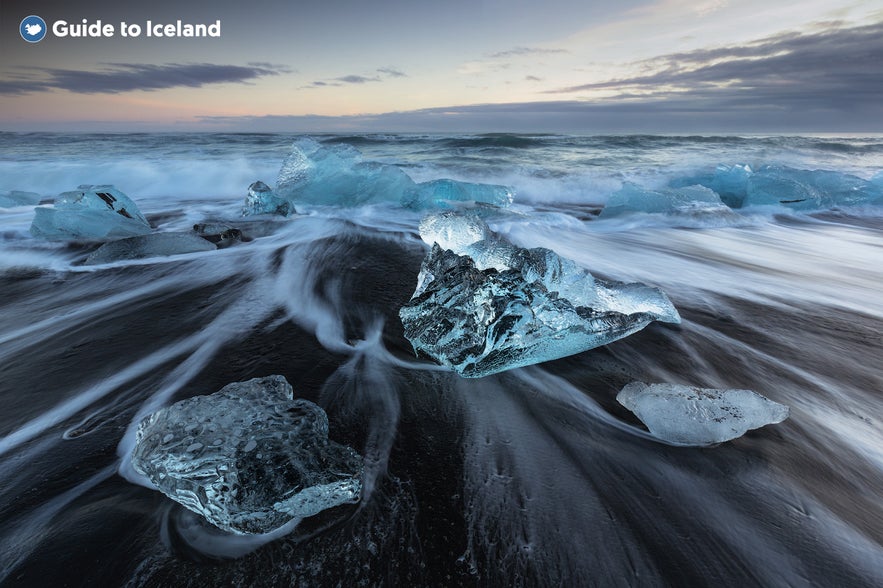
The Jokulsarlon Glacier Lagoon is one of Iceland's most iconic attractions—a place where towering icebergs float around in a gorgeous lake filled with water from nearby Breidamerkurjokull Glacier. Icebergs make their way through the lagoon, sometimes ending up on the shores of the famous Diamond Beach.
Also known as Breidamerkursandur, Diamond Beach is a glacial outwash plain with vast stretches of black sand. Icebergs glisten like gemstones as they gather on the beach.
Diamond Beach is a popular stop for travelers on the Ring Road. The contrast of shimmering icebergs against the black sand beneath them is nothing short of magical. It’s so other-worldly you’d think it’s a computer-generated image.
Visiting the Jokulsarlon Glacier Lagoon and Diamond Beach is an enchanting experience. The landscape is so enthralling that many visitors stay at a nearby hotel to get the most out of their trip. Zodiac boat tours offer a close look at the vivid blue icebergs.
1. Reynisfjara Beach
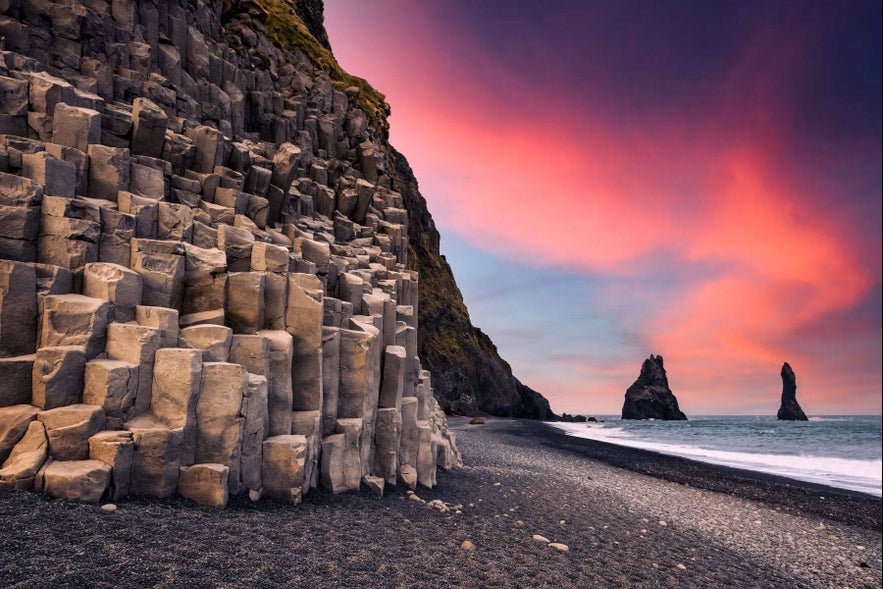 One of Iceland's most famous attractions is Reynisfjara Beach, near the coastal village of Vik. Readily accessible from the Ring Road, the beach draws flocks of visitors eager to admire the surrounding landscape. The North Atlantic puffins that nest on the cliffs of the mountain overlooking the shore also draw visitors.
One of Iceland's most famous attractions is Reynisfjara Beach, near the coastal village of Vik. Readily accessible from the Ring Road, the beach draws flocks of visitors eager to admire the surrounding landscape. The North Atlantic puffins that nest on the cliffs of the mountain overlooking the shore also draw visitors.
The dramatic Reynisdrangar sea stacks rise from the waves just offshore. According to legends, these imposing basalt columns were once trolls that tried to pull ships from the ocean but turned to stone as dawn broke.
Reynisfjara Beach is surrounded by bird cliffs where puffins, fulmars, and guillemots often nest, especially during the summer. This is an ideal spot for observing wildlife, adding another layer of interest to the already captivating environment.

While visually arresting, Reynisfjara Beach commands respect. Sneaker waves strike suddenly and carry away visitors who ignore the warning signs. It’s advised to never turn your back on the waves and keep a safe distance of at least 100 feet (30 meters) from the water.
Exploring Reynisfjara Beach is a must when visiting the South Coast. Consider taking a 10-hour small-group tour of the South Coast, where you’ll see natural wonders such as Seljalandsfoss Waterfall.
Adventure seekers should consider this South Coast minibus tour with glacier hiking and explore the scenery at Solheimajokull Glacier.
If you’re drawn to the beauty of the area, book a hotel in Vik and enjoy easy access to Reynisfjara Beach. The village serves nicely as a base of operations while visiting the South Coast and its many wonders. There are excellent Vik tours and travel packages available for an exciting trip.
Other Beaches Iceland Has To Offer
 Iceland's geology is quite varied, and there are plenty of beaches with white or golden sands. Here are some of the most well-known.
Iceland's geology is quite varied, and there are plenty of beaches with white or golden sands. Here are some of the most well-known.
Nautholsvik Beach
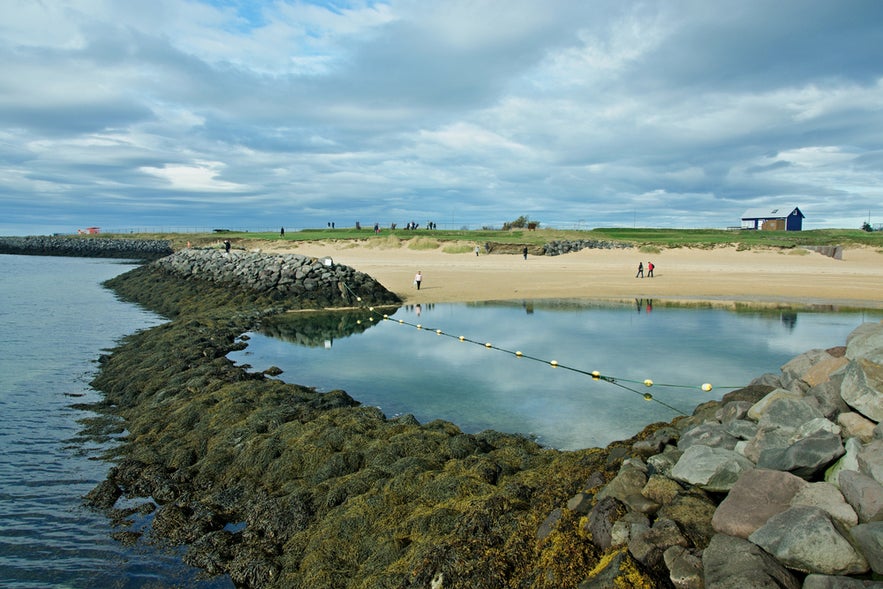 Nautholsvik Beach is man-made, with light sand and plenty of public facilities. When the weather is nice, locals flock to this beach to enjoy some tropical fun in the North Atlantic.
Nautholsvik Beach is man-made, with light sand and plenty of public facilities. When the weather is nice, locals flock to this beach to enjoy some tropical fun in the North Atlantic.
Geothermal heating warms the icy waters of the Atlantic Ocean within a barricaded bay, where guests enjoy sunbathing to their heart's content. The beach boasts two outdoor hot tubs, a sauna, dressing rooms, a volleyball net, and the upscale restaurant Strandkaffi.
Nautholsvik Beach is conveniently located in Reykjavik. Make it part of your city plans if the weather allows. One of the city's most iconic landmarks, Perlan Museum, is nearby. Keep a visit to the beach as an option if you're exploring Reykjavik on the hop-on, hop-off bus tour.
Raudasandur Beach
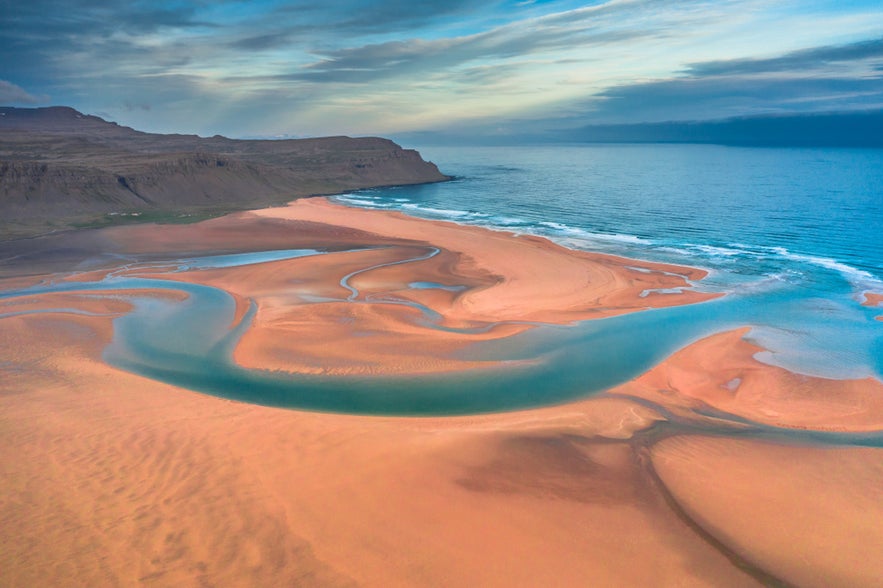 Raudasandur Beach is a unique spot in the Westfjords. Raudasandur translates to "red sand," which fits the reddish-golden hue of the beach. The composition of pulverized red and pink shells and other marine organisms creates this unusual color.
Raudasandur Beach is a unique spot in the Westfjords. Raudasandur translates to "red sand," which fits the reddish-golden hue of the beach. The composition of pulverized red and pink shells and other marine organisms creates this unusual color.
The beach is rarely crowded due to its isolated location. Visitors must traverse winding mountain roads to reach it but are rewarded with a quiet, almost meditative atmosphere. The beach stretches for about 6 miles (10 kilometers) across the coastline and is home to various species of birds and marine wildlife.
There are many stories surrounding Raudasandur Beach, one of which involves ghastly murders in the 1800s. To get more insight into the folklore and myths surrounding the region, consider a scenic 6-hour walking tour to Raudasandur Beach.
Breidavik Beach
 Breidavik Beach is also located in the Westfjords. Steep mountains embrace the beach on each side, while an old farmhouse by the sea provides the most scenic of views.
Breidavik Beach is also located in the Westfjords. Steep mountains embrace the beach on each side, while an old farmhouse by the sea provides the most scenic of views.
Visiting the area feels a bit like traveling in Iceland decades ago. A camping site and a river rich with trout offer the perfect getaway for those looking for peace and quiet. Over the bay is a small white church donning the quintessential red roof of its Icelandic counterparts.
Although the scenery should be reason enough to make your way across the unpaved mountain roads, most people visit Breidavik Beach for the North Atlantic puffins. They return to breed on the Latrabjarg Cliffs from April to September.
Budir Beach
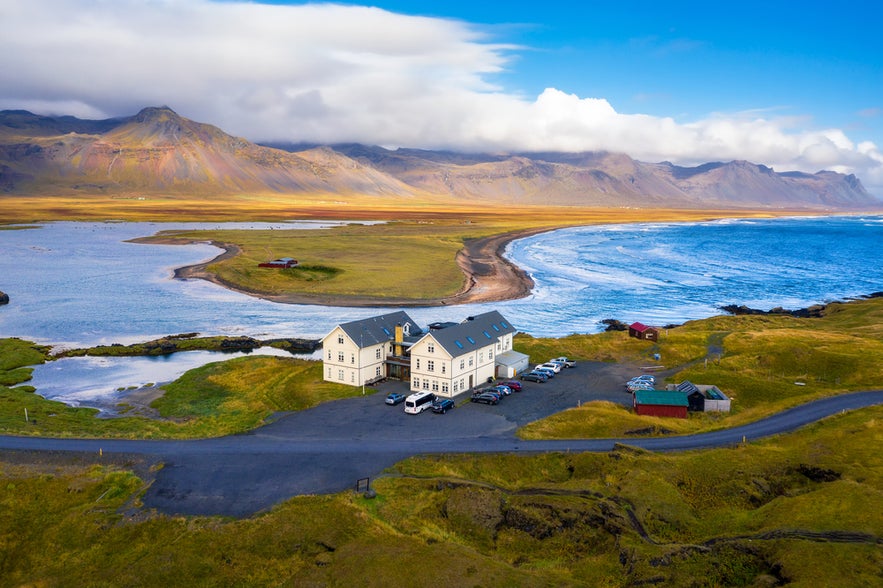 Budir Beach is a popular photo op in the Snaefellsnes Peninsula, mostly thanks to the iconic Budarkirkja Church. A short distance from the church, tall windswept grass makes way for a soft blanket of fair-colored sand dotted with jet-black lava rocks.
Budir Beach is a popular photo op in the Snaefellsnes Peninsula, mostly thanks to the iconic Budarkirkja Church. A short distance from the church, tall windswept grass makes way for a soft blanket of fair-colored sand dotted with jet-black lava rocks.
The area used to be a prominent fishing village and was one of the country's earliest trading posts. But like most settlements in the area, it was abandoned at the beginning of the 19th century.
Aside from its church and mystical atmosphere, little of the village remains today. Curious seals are often seen lounging in the shallows offshore.
Ytri-Tunga Beach
 Ytri-Tunga Beach is another scenic shoreline on the Snaefellsnes Peninsula. It has a rocky terrain that's usually covered in seaweed. This quiet area is one of the most reliable beaches to spot seals.
Ytri-Tunga Beach is another scenic shoreline on the Snaefellsnes Peninsula. It has a rocky terrain that's usually covered in seaweed. This quiet area is one of the most reliable beaches to spot seals.
The seal colony at Ytri-Tunga Beach is especially prevalent in the summer. Getting a look at these animals, who seem quite at home along the coast, provides one of the most unique wildlife-watching experiences in Iceland.
When visiting Ytri-Tunga Beach, be mindful that sudden movements and loud voices stress out the seals. Maintain a reasonable distance, especially during pupping season when mothers are likely more defensive. This way, you can observe the fascinating creatures in their natural habitat without intruding.
The Dangers of Sneaker Waves
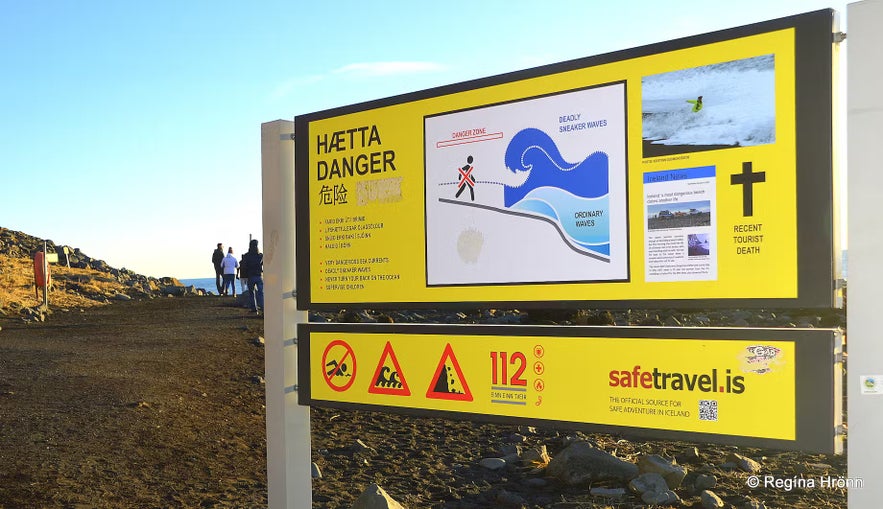
Understanding sneaker waves is important if you plan on visiting beaches in Iceland. These are coastal waves that are significantly larger and stronger than the waves preceding them. Sneaker waves quickly surge far up the beach with great force. They can catch beachgoers off-guard and drag them into the sea.
These dangerous waves are difficult to predict, as they don’t follow a regular pattern. They’re separated by long periods of smaller, gentler waves, lulling beachgoers into a false sense of security.
Sneaker waves are more common on beaches that are openly exposed to strong ocean currents. Warning signs include unusually calm water or the ocean suddenly receding away from the beach. If you notice this happening, maintain a safe distance and alert everyone around you.
Tours That Feature Some of the Best Beaches in Iceland
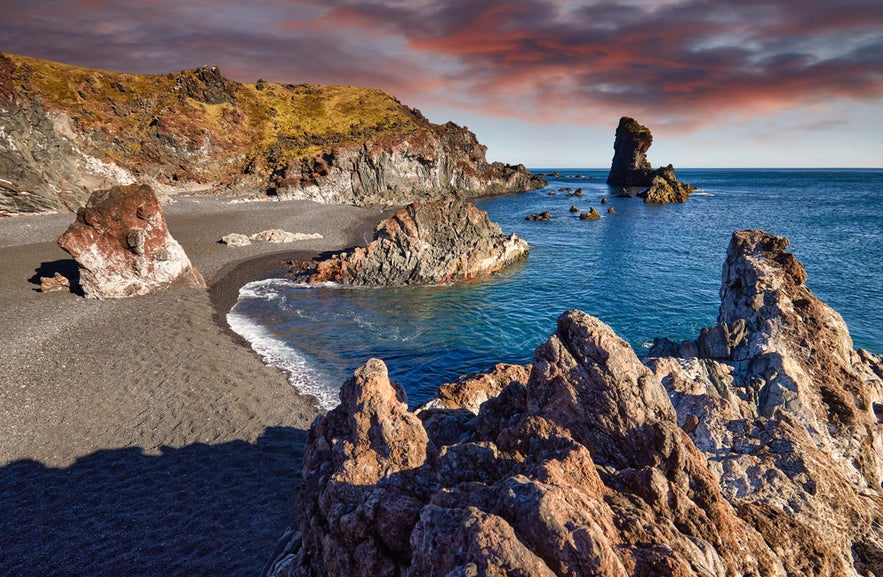 Exploring the country’s beaches and coastlines is an experience you won’t soon forget. Consider the following tours and plan the trip to Iceland that’s right for you.
Exploring the country’s beaches and coastlines is an experience you won’t soon forget. Consider the following tours and plan the trip to Iceland that’s right for you.
-
10-Day Circle of Iceland Self-Drive — Explore every corner of Iceland at your own pace and see glaciers, waterfalls, volcanic landscapes, and black sand beaches.
-
Horse Riding Tour on the Black Sand Beach From Vik — Take a ride down one of Iceland’s most popular black sand beaches and see breathtaking cliffs and picturesque landscapes.
-
South Coast Waterfall and Black Sand Beach Day Trip — Spend the day taking in unique coastlines, majestic mountains, and powerful glaciers.
-
Guided ATV Tour of Lava Fields and Black Sand Beach — Speed through the South Coast on an ATV as you explore the Reykjanes Peninsula, amazing lava fields, and black sand beaches.
Find Your Favorite Icelandic Beaches
Check out the map below to find all of Iceland’s black sand beaches.
FAQs About Black Sand Beaches in Iceland
Visiting Iceland's unique black sand beaches can bring up many questions. To help you prepare for your adventure, we've compiled some frequently asked questions below.
What should I wear when visiting black sand beaches?
It’s important to dress warmly and wear sturdy, waterproof footwear. The weather can be unpredictable, with strong winds, rain, and cold temperatures, even in summer. Layer your clothing and bring a jacket to protect against the cold winds.
When is the best time to visit black sand beaches in Iceland?
The best time to visit is during the summer months when the weather is milder and the days are longer. However, winter is also a magical time—especially for those interested in seeing the northern lights over the beaches.
Can I swim at Iceland’s black sand beaches?
Swimming is not recommended at most black sand beaches due to strong currents and the dangerous nature of the Atlantic Ocean waves. The water is also very cold year-round. If you plan to swim, ensure you are in designated swimming areas with lifeguards.
How do I photograph Iceland’s black sand beaches?
Early mornings or late evenings offer the best lighting for dramatic shots, especially when the sun is lower in the sky. Using a wide-angle lens can help capture the vastness of the beach.
Is there an entrance fee for visiting Iceland’s black sand beaches?
No, there is typically no entrance fee to visit the black sand beaches in Iceland. However, some visitor centers or parking lots may charge a small fee for parking.
Can I walk barefoot on the sand?
While you can walk barefoot, it’s generally not recommended on the black sand beaches in Iceland. The sand can be sharp, and the temperatures can be cold, even in summer.
Can I camp near Iceland’s black sand beaches?
Yes, there are authorized campsites in the vicinity of several black sand beaches. For example, Vik has a campsite, and Solheimasandur has nearby options. Wild camping (camping outside of designated areas) is restricted under Icelandic law in most areas unless explicitly permitted.
How close can I get to the cliffs at the beaches?
While it’s safe to visit the cliffs at black sand beaches, you should exercise caution. Some cliffs are steep and unstable, often with no safety rails. Be sure to stay at a safe distance from the edge to avoid accidental falls.
What should I pack to visit a black sand beach in Iceland?
For a safe and comfortable visit to Iceland’s black sand beaches, be sure to pack the following:
-
Sturdy waterproof footwear
-
A good camera
-
Waterproof outerwear
-
Sunscreen and sunglasses
Are there any beaches in Iceland with volcanic activity nearby?
Yes. Many of Iceland’s beaches are near volcanic regions, and volcanic activity can sometimes impact the coastline.
Bask in the Sun at an Icelandic Beach
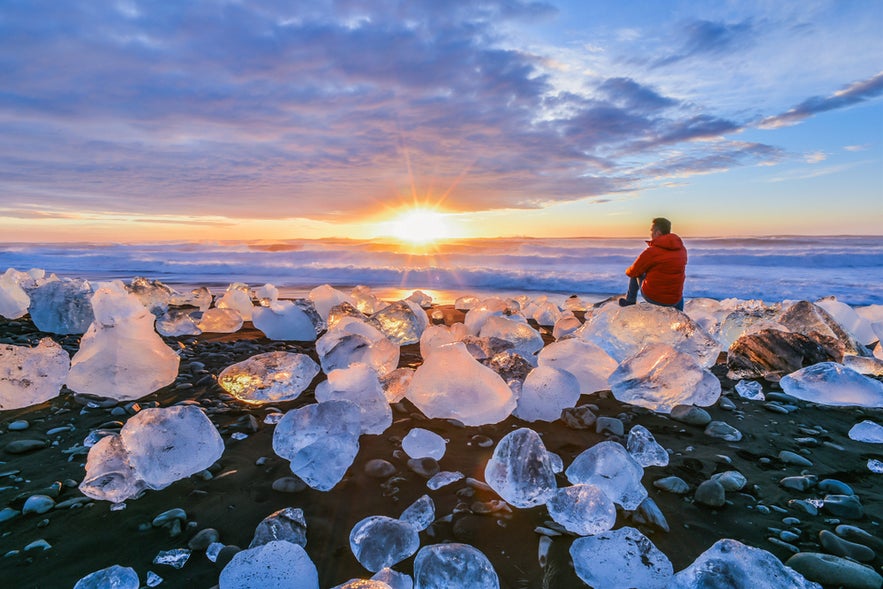 The beaches of Iceland are sure to leave you with lasting memories. So pack your waterproof gear, bring your camera, and prepare to be amazed. The black sand beaches of Iceland await, ready to share their stories and untamed beauty with you.
The beaches of Iceland are sure to leave you with lasting memories. So pack your waterproof gear, bring your camera, and prepare to be amazed. The black sand beaches of Iceland await, ready to share their stories and untamed beauty with you.
And who knows—perhaps you'll even discover your own hidden gem along the rugged coastline of this extraordinary island. Iceland is full of secret spots waiting to be uncovered, from secluded beaches to off-the-beaten-path hiking trails.
Have you chosen which beaches you plan on visiting during your trip? Let us know in the comments below.


